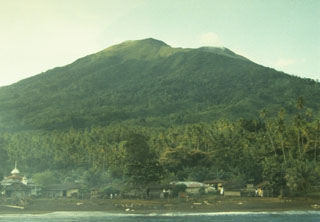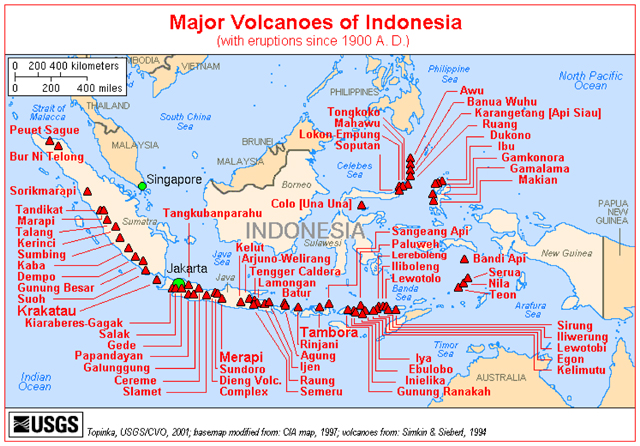Report on Gamkonora (Indonesia) — April 2012
Bulletin of the Global Volcanism Network, vol. 37, no. 4 (April 2012)
Managing Editor: Richard Wunderman.
Gamkonora (Indonesia) Instability followed by confusing news claims of minor June 2012 eruption
Please cite this report as:
Global Volcanism Program, 2012. Report on Gamkonora (Indonesia) (Wunderman, R., ed.). Bulletin of the Global Volcanism Network, 37:4. Smithsonian Institution. https://doi.org/10.5479/si.GVP.BGVN201204-268040
Gamkonora
Indonesia
1.38°N, 127.53°E; summit elev. 1635 m
All times are local (unless otherwise noted)
Previous Bulletin reports on Gamkonora highlighted an eruption in 1981, minor explosions in April 1987 (SEAN 06:07), and a phreatic eruption in early July 2007 (BGVN 32:10). Reports by the Center of Volcanology and Geological Hazard Mitigation (CVGHM) noted tiny diffuse white plumes in 2009 and again in 2011 when the observatory recorded an average of 2 volcanic earthquakes per day. During mid-2011 through mid-2012, in addition to intervals with several shallow volcanic earthquakes per day, instruments also recorded increasing tremor and hundreds of signals of inferred emissions described as hot-air blasts. The hazard status rose accordingly and remained elevated as this report goes to press on 29 June 2012 at Alert Level 3 (on a scale of 1-4).
As this report goes to press a potentially inaccurate news report indicated an eruption starting 13 June 2012 (see subsection below). That behavior remained unconfirmed by CVGHM or the Darwin Volcanic Ash Advisory Centre (VAAC) as discussed further in a subsection below.
Figures 2-4 provide broad regional context on Gamkonora near the northern margin of Indonesia. A previous map (figure 1 in BGVN 32:10) shows Gamkonora and other Holocene volcanoes on a map of Halmahera and adjacent islands.
CVGHM reports were scarce during 1982-2011. One report noted that seismic activity increased somewhat on 24 March 2008. The increase included an episode of continuous tremor.
On 23 March 2009, CVGHM lowered the Alert Level from 2 to 1 based on visual observations and decreased seismicity since January. Diffuse white plumes rose 50-150 m above the crater. Residents and visitors were reminded not to approach or climb into the crater.
CVGHM reported that during January-April 2011, diffuse white plumes rose 25-100 m above Gamkonora's crater rim. Seismicity increased during 29 April-3 May 2011.
On 1 May, white plumes rose 150 m above the crater rim. The next day, white plumes were observed rising 300 m above the crater rim and observers saw incandescence from the crater. Residents near the volcano's base noted a sulfur smell. On 3 May 2011 the Alert level was raised to 2.
Various types of earthquakes were noted during January to April 2011. They included shallow volcanic earthquakes (2 per day average), deep volcanic earthquakes (once per day average), local tectonic earthquakes (1-7 per day average), and far tectonic earthquakes (4 per day average).
A 13 June 2012 CVGHM report noted that during May and June 2012 the emissions were sparsely to medium white in color and rising 75 to 200 m above the crater rim. Absent were sulfurous smells, open flames, eruptive noises, and other similar anomalous symptoms.
The same CVGHM report noted that seismic signals since 3 May 2010 included emission signals (hot-air blasts, averaging 10-12 daily), harmonic tremor (averaging 10-15 events daily), shallow volcanic earthquakes (averaging 2 daily, but for the one specific case given, during the interval 31 May to 11 June 2012, only 1 occurred), and distant tectonic earthquakes (averaging 4 daily). Table 1 presents a breakdown of the interpreted seismic signals during 1 May to 12 June 2012.
Table 1. Seismic data released on 13 June 2012 for Gamkonora. The entries represent total events during specified intervals during May and early June 2012 ("--" signifies absence of data). Courtesy of CVGHM.
| Dates | Tremor Events (amplitude range) | Emission signals | Deep volcanic | Distant tectonic | Local tectonic |
| 01 May-10 May 2012 | 125 (2-14 mm) | 22 | 18 | 49 | -- |
| 11 May-20 May 2012 | 186 (1.5-10 mm) | 81 | 4 | 54 | -- |
| 21 May-30 May 2012 | 233 (2-13 mm) | 209 | 2 | 48 | 95 |
| 31 May-11 Jun 2012 | 246 (2-7 mm) | 183 | 8 | 49 | -- |
| 12 Jun 2012 | 38 (2-5 mm) | 2 | -- | 1 | 2 |
The authors of the 13 June report made no further comment about the air-blast signals that had become common at the volcano (table 1). They did note that since the beginning of May 2012, tremor had increased. They interpreted this and the overall seismicity as due to magma intruding upward and approaching shallow depths within the volcano. The authors noted that intrusions could lead to increased pressure within the volcano, although they viewed this pressure as yet relatively small.
As previously noted, starting on 3 May 2011, the volcano's hazard status rose to Alert Level 2. On 3 May 2012 it rose to Level 3, where it remained at least as late as 29 June 2012. The Level 3 status excluded residents, visitors, and tourists from approaching closer than 3 km from the summit. The report also prompted local governments to coordinate with the volcano's monitoring post, which is located in the village of Gamsungi (or with CVGHM's main office in Bandung).
News claims of eruption on 13 June 2012. The English language version of Antara News released a report (edited by Ella Syafputri) at 1913 on 13 June stating that Gamakonora had erupted that afternoon. The eruption, if it did occur, escaped clear mention in available CVGHM reports. The news report said that the eruption sent a plume of undisclosed type or color 3 km "into the sky" (a term that could imply a plume to 3 km altitude or could mean a plume 3 km over the ~1.6 km summit, in effect to ~4.6 km altitude). The news report said the event had the effect of "forcing hundreds of residents living on the volcano's slope to evacuate to safer areas."
Despite the headline "Mount Gamkonora erupts" and directly under that, the sentence "The volcanic ash spread to as far as Tobelo, the capital of North Halmahera district", the two quotes referred to events at two separate volcanoes. In the 5th paragraph of the article the topic shifted to Dukono, another volcano in the region, which turned out to have been the source of the ash (not Gamkonora).
The news report spawned no fewer than 10-20 English-language reports on as many websites. Some of these derivative reports continued to mistakenly attribute Dukono ashfall to Gamkonora, and in some cases they added further errors.
Reference. Simkin, T. and Siebert, L., 1994, Volcanoes of the World: a Regional Directory, Gazetteer, and Chronology of Volcanism During the Last 10,000 Years. (2nd ed.) Geoscience Press, Tucson, 368 pp.
Geological Summary. The shifting of eruption centers on Gamkonora, the highest peak of Halmahera, has produced an elongated series of summit craters along a N-S trending rift. Youthful-looking lava flows originate near the cones of Gunung Alon and Popolojo, south of Gamkonora. Since its first recorded eruption in the 16th century, typical activity has been small-to-moderate explosive eruptions. Its largest recorded eruption, in 1673, was accompanied by tsunamis that inundated villages.
Information Contacts: Center of Volcanology and Geological Hazard Mitigation (CVGHM), Jalan Diponegoro 57, Bandung 40122, Indonesia (URL: http://www.vsi.esdm.go.id/); Lyn Topinka, United States Geological Survey, 1300 SE Cardinal Court, Bldg. 10, Suite 100, Vancouver, WA, 98683; UNOSAT (URL: https://unitar.org/unosat/); Darwin Volcanic Ash Advisory Centre (VAAC), Bureau of Meteorology, Northern Territory Regional Office, PO Box 40050, Casuarina, NT 0811, Australia (URL: http://www.bom.gov.au/info/vaac/); Antara News (URL: http://www.antaranews.com/en/news/).




